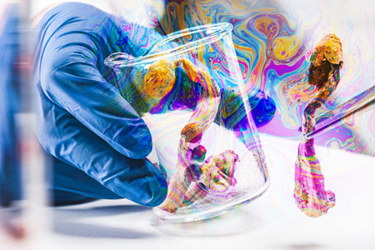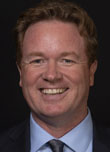Reimagining Psychedelics: Mental Wellness Without the Roadblocks

By Katie Anderson, Chief Editor, Pharmaceutical Online

Psychedelic drugs have been on quite the trip. Though they have been used culturally for thousands of years for medicinal and spiritual reasons—from psilocybin-containing mushrooms in Aztec rituals to the iboga plant used by Bwiti shaman in Africa and indigenous Amazonian groups using ayahuasca—their entry into modern chemistry and Western medicine didn’t begin until the 20th century.
The end of the 19th century and the beginning of the 20th century saw a number of discoveries in psychedelic chemistry. Mescaline and ibogaine were isolated from nature, and later MDMA and LSD were synthesized, leading to developments in psychedelics for psychotherapy. But that all came to a screeching halt with the counterculture movement of the 1960s, where a decade of experimentation with drugs including psychedelics led to their illegal classification and prohibition by federal agencies in the 1970s.

Psychedelics In Today’s Healthcare
The therapeutic benefit of psychedelics for mental health disorders such as depression, anxiety, and post-traumatic stress disorder has been shown in studies. There are major hurdles to their use; safety, accessibility and legality often stand in the way.
Though their therapeutic benefit has been shown, psychedelics remain Schedule 1 illegal drugs in most of the United States, and the world for that matter, with legal use under clinical supervision in Colorado and Oregon, along with a host of other cities across the United States.
The. U.S. Food and Drug Administration (FDA) has yet to approve a psychedelic drug for prescription use, though its hallucinogenic cousin dissociative drugs ketamine and esketamine are approved for use in anesthesia and depression, respectively.
This may change in the near future, with psilocybin, LSD and MDMA all in phase 3 clinical trials. Though eventually, these drugs will likely come on the market, there are still going to be those wary of their use. Tucker’s group at Enveric and a few other sponsors have sought to change that.
A “No-Trip” Variant For Mental Health
Many of the indigenous groups that used psychedelics did so for spiritual reasons. When it comes to mental health, though, is it the hallucination that is making the improvement, or is the hallucination merely a side effect? That is the question that Tucker asked himself before developing the company’s synthetic psychedelic derivative EB-003.
Enveric went into its Psybrary (repository of synthetic derivatives from classic psychedelics) and managed to synthesize a molecule that produces the results of a psychedelic but does not have the hallucinogenic results.
Though it has not yet been tested in humans, EB-003’s animal studies have shown promising results.
“In animals, we have tested our EB-003 head to head with the classic psychedelics psilocin [psilocybin] and DMT [ayahuasca], and we get exactly the same score on an efficacy point of view from a single dose,” noted Tucker. He added that his company is one of a few working on non-hallucinogenic variants of psychedelics that maintain their efficacy.
Tucker is preparing his IND for EB-003 but is excited about where the sector is headed in pharmaceuticals. “At this point, there are no human trials of a non-hallucinogenic completely novel molecules from a phase 2 that have been released.”
Tucker believes that EB-003 can produce the same mental health benefit of psychedelics, and because there are no hallucinations, it can be used more frequently for even better efficacy. “You can’t take classic psychedelics every day. They require a long psychotherapy session up to 8 hours and healthcare providers watching over you. With our non-hallucinogenic, we think you probably take it more frequently. We don't yet know, but what we've seen so far in animals is you could conceivably take this drug every single day. So, I would imagine if you could take the non-hallucinogenic every single day, it would be much more effective over time,” Tucker furthered.
Regulation: Keep Calm and Carry On
Without the hallucinogenic effects, EB-003 doesn’t face the same regulatory hurdles as its hallucinogenic sister drugs. It does, however, have to prove its non-hallucinogenic properties before it gets treated like any other New Drug Application.
“We are going to be showing the regulators that, yes, it is a neuroplastogen, but we’ve already done testing like you would normally do to quantify hallucinogenicity of our molecule to show that we are at zero. Once, we show regulators that our molecule does not cause hallucinations, there's no abuse potential, and we get treated like a normal NDA. That's our expectation,” added Tucker.
Enveric has already started talking to the FDA, and the agency encouraged the company to carry on with its current direction. However, even before it began its conversation with the FDA, it started a dialogue with the DEA to avoid any criminal ramifications. “We also were very proactive, and years ago started a dialogue with the DEA when we were doing our early manufacturing and shipping molecules around. We wanted to know if we were we going to run into any hurdles via the DEA when it came to transshipment and those sorts of things. And the DEA came back and said, no your molecules are non-hallucinogenic carry-on.”
A bit of a caution came into play in summer 2025 for the psychedelic pharmaceutical community when Lykos’ MDMA drug for PTSD was rejected by the FDA. According to Tucker, that rejection was largely because the company failed to separate expectation bias, which may be an issue for other psychedelics.
“When your trial is a depression marker, it's a really big deal that you can separate out expectation bias, which really is placebo. All classic psychedelics are going to have this problem, because the patient is going to know if they are taking the drug or the placebo. If they know they are taking the drug, they are going to feel less depressed. We are going to be in a different boat, because there are no hallucinogenic effects. The patient won’t know if they have received the drug or the placebo,” Tucker explained.
Further, Tucker noted that you cannot rely on societal significance of your therapy when seeking FDA approval. “You have to satisfy the data that the FDA needs, or you are not going to get approved. That was a big takeaway for us. The world may need a better treatment for depression, but the data must be there.”
Simplifying Manufacturing With Chemical Synthesis
Manufacturing the API for EB-003 is straightforward, but it almost didn’t end up that way. “During our screening process, we started using a biosynthetic approach to screen, which was slower, more expensive, but created a diversity of molecules that you couldn't reach with chemical synthesis. So, we did that with a large number of molecules, and out of luck more than anything else, the one we ended up settling on does have a simple, straightforward chemical synthesis method,” explained Tucker.
The manufacturing of the API, and the final drug for that matter, could have been a challenge for Enveric, had it gone the traditional psychedelic route. It would have had to have a Schedule I license from the DEA to handle the material and ship it; however, its non-hallucinogenic molecule requires no special license.
“Luckily we have found a simple, classic small molecule chemical synthesis method that's cost effective and can be handled with standard equipment by any GMP CDMO,” added Tucker. He also added that it doesn’t’ require any scheduled precursors, so the company can ship the molecule and the starting ingredients all around the world.
The company plans to work with CDMO partners to scale, and already has some partners manufacturing for them. Tucker believes they can scale to a certain level, but at the point where large quantities are needed, he may have to come up with a new plan.
Approaching Clinical Trials and Beyond
Tucker is hopeful and excited about the future of psychedelics and their derivatives. Though Lykos’ MDMA therapy was not approved, Tucker believes that prescription psychedelics are in the near future, with encouraging phase 2 and phase 3 results for LSD, 5-methoxy-DMT and psilocybin.
And he hopes they get approved, finding that hallucinogenic and non-hallucinogenic treatments can work together to treat mental health disorders in both the short and long term.
In the meantime, Enveric is preparing its IND for submission in the first quarter of 2026 and hopes to be in clinical trials in the second quarter of 2026. After what it hopes to be successful early clinical data, the company may follow in its psychedelic predecessors’ footsteps and file for breakthrough therapy designation. “We see efficacy in an hour in the animal models, so if that translates to humans, breakthrough designation should be very achievable for us,” he noted.
Though Enveric’s EB-003 presents promise for the treatment of PTSD, depression and anxiety, the company’s other neuroplastogenic molecules from classic psychedelics present even more opportunities for mental health. By reimagining psychedelics, we are able to rewire the brain and potentially change the field of neuropsychiatry for the better.
